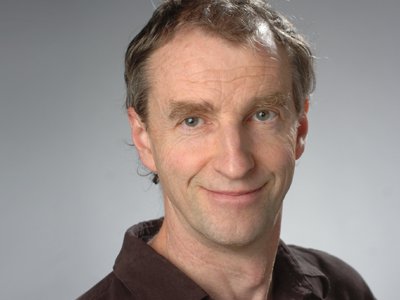Simon Catterall Elected American Physical Society Fellow
Professor Simon Catterall recognized for lattice field theory work

Professor of Physics Simon Catterall was recently elected as an American Physical Society (APS) Fellow. The APS Division of Computational Physics nominated Catterall for his contributions to lattice field theory, a framework used to explore how subatomic particles interact, yielding insights into how matter behaved shortly after the Big Bang.
“It's very gratifying to see that one's research is appreciated by the wider community of physicists. This is work that I have been pursuing for more than a decade, and it’s been exciting. We have made a lot of progress and its nice to see that it is well recognized,” Catterall says.
The APS is a nonprofit organization that aims to promote physics through publishing top-notch physics journals, sponsoring scientific meetings and performing outreach. Catterall’s work has been published in APS journals including Physical Review D and Physical Review Letters. The organization elects fellows based on an APS member’s “exceptional contributions to the physics enterprise.”
“This is well-deserved recognition for Simon's invention of new ways to simulate the physics of subatomic particles using supercomputers,” says Alan Middleton, professor and department chair. “It is most impressive that Simon made these contributions while also being an outstanding teacher and serving administratively as associate chair.”
Catterall’s recognized work focuses on the use of lattice field theory methods to explore extensions of the so-called Standard Model of particle physics, which describes the most elementary particles of nature and their interactions. For example, because the nucleus of an atom is made up of even smaller particles, known as quarks, lattice field theory can describe the structure of an atom’s nucleus based on the quark’s interactions.
“Understanding how the nucleus of an atom works can be used to predict the behavior of matter at extreme densities and pressures—such as in neutron stars or at times shortly after the Big Bang,” Catterall says.
Beyond that, Catterall’s work attempts to reconcile two areas of study in physics: general relativity, which describes the universe at large scales, and quantum mechanics, which deals with the very, very small. To this end, he works on theories of quantum gravity, which take into account quantum fluctuations of gravity. Recently, this has included using numerical simulations to study a newly conjectured spacetime symmetry called “supersymmetry,” which connects particles mediating forces with matter particles.
“Efforts to look for new physics beyond the Standard Model are concerned with really big questions, like ‘What is the origin of mass for fundamental particles? Are there extra dimensions of space? How do we merge quantum mechanics with Einstein's theory of general relativity?’ Lattice gauge theory methods are useful in answering all of these questions,” Catterall says.
Catterall belongs to a four-faculty-member theory group, with two post-doctoral scholars and nine graduate students as well as undergraduate researchers. They are funded by a Department of Energy grant supporting research ranging from Catterall’s specialty of lattice gauge theory to exploring physics at play in the early universe to explaining experimental results from the Large Hadron Collider at the European Organization for Nuclear Research (CERN).
Catterall is the 21st professor in Syracuse’s lauded physics department to be awarded this honor since the first fellow was elected in 1949. Current Syracuse APS Fellows include physics professors Marina Artuso, Mark Bowick, Duncan Brown, Cristina Marchetti, Alan Middleton, Peter Saulson, Eric Schiff, Tomasz Skwarnicki, Paul Souder, Sheldon Stone and Gianfranco Vidali, as well as engineering and computer sciences professor Mark Glauser.
